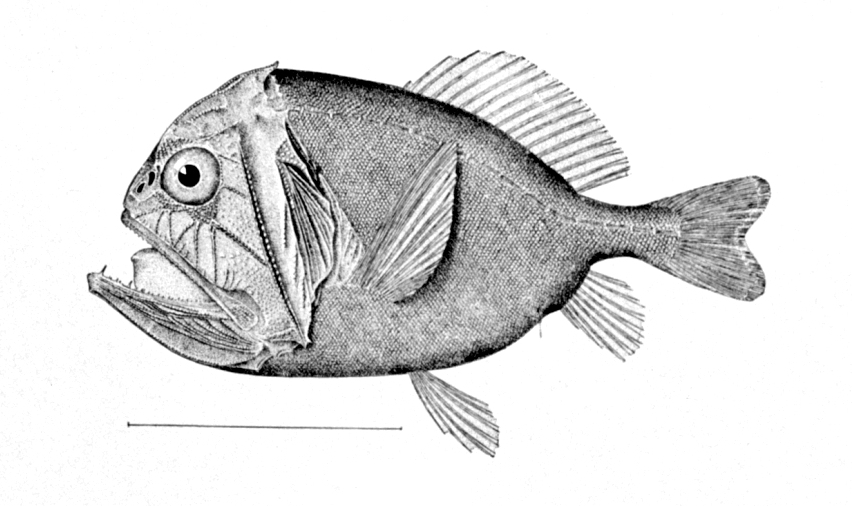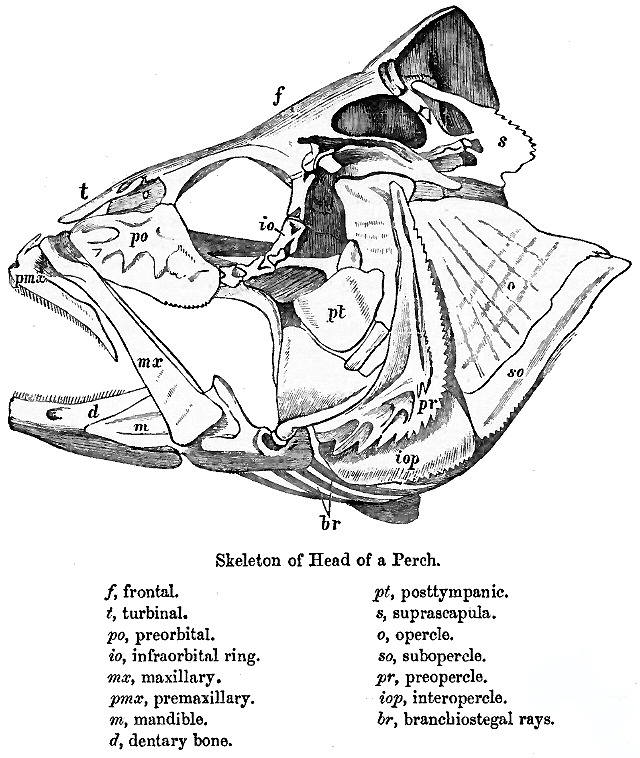|
Acanthopterygii
Acanthopterygii (meaning "spiny-finned one") is a superorder of teleost, bony fishes in the class Actinopterygii. Members of this superorder are sometimes called ray-finned fishes for the characteristic sharp, bony rays in their fins; however this name is often given to the class Actinopterygii as a whole. The suborder includes the Berycidae, berycids and their allies, but by far the largest member of the group is the Percomorpha, the most diverse vertebrate clade. Taxonomy The following taxonomy is based on ECoF (2025), with subseries based on earlier studies: * Series Berycida ** Order Trachichthyiformes, including Monocentridae, pineconefishes, Slimehead, slimeheads & Fangtooth, fangtooths ** Order Beryciformes *** Suborder Holocentridae, Holocentroidei, Holocentrinae, squirrelfish & Myripristinae, soldierfish *** Suborder Berycoidei, Alfonsino, alfonsinos & Berycidae, berycids *** Suborder Stephanoberyciformes, Stephanoberycoidei, Stephanoberycidae, pricklefishes, Cetomim ... [...More Info...] [...Related Items...] OR: [Wikipedia] [Google] [Baidu] |
Trachichthyiformes
The Trachichthyiformes are an order of ray-finned fishes in the superorder Acanthopterygii. Fossils of this group date back to the Cenomanian. Member genera include the flashlight fishes, fangtooth fishes, spinyfins, pineconefishes, redfishes, roughies, and slimeheads. A number of member species are caught Commercial fishing, commercially, most notably the orange roughy. Some species have bioluminescent bacteria contained in pockets of skin or in light organs near the eyes, including the anomalopids and monocentrids. Phylogeny A recent phylogeny based on the work of Betancur-Rodriguez ''et al.'' 2017 shows Trachichthyiformes as a sister group of Beryciformes in the clade Berycimorpha. References * Hgulichthys, nouveau genre de Lissoberycinae (Trachichthyiformes, Trachichthyoidea) du Cénomanien inférieur marin de Hgula (Liban). Implications ... O Otero, Y Dutour, M Gayet, Geobios, 1995 Ray-finned fish orders Trachichthyiformes, {{Trachichthyiformes-s ... [...More Info...] [...Related Items...] OR: [Wikipedia] [Google] [Baidu] |
Beryciformes
The Beryciformes are a poorly-understood Order (biology), order of carnivorous ray-finned fishes consisting of 7 families, 30 genera, and 161 species. They feed on small fish and invertebrates. Beyond this, little is known about the biology of most member species because of their nocturnal habits and deepwater habitats. All beryciform species are marine and most live in tropical to temperate, deepwater environments. Most live on the continental shelf and continental slope, with some species being found as deep as . Some species move closer to the surface at night, while others live entirely in shallow water and are nocturnal, hiding in rock crevices and caves during the day. Several species are mesopelagic and bathypelagic. Beryciformes' bodies are deep and mildly compressed, typically with large eyes that help them see in darker waters. Colors range from red to yellow and brown to black, and sizes range from . Member genera include the alfonsinos, squirrelfishes, pricklefishes, ... [...More Info...] [...Related Items...] OR: [Wikipedia] [Google] [Baidu] |
Teleost
Teleostei (; Ancient Greek, Greek ''teleios'' "complete" + ''osteon'' "bone"), members of which are known as teleosts (), is, by far, the largest group of ray-finned fishes (class Actinopterygii), with 96% of all neontology, extant species of fish. The Teleostei, which is variously considered a Division (zoology), division or an infraclass in different taxonomic systems, include over 26,000 species that are arranged in about 40 order (biology), orders and 448 family (biology), families. Teleosts range from giant oarfish measuring or more, and ocean sunfish weighing over , to the minute male anglerfish ''Photocorynus spiniceps'', just long. Including not only torpedo-shaped fish built for speed, teleosts can be flattened vertically or horizontally, be elongated cylinders or take specialised shapes as in anglerfish and seahorses. The difference between teleosts and other bony fish lies mainly in their jaw bones; teleosts have a movable premaxilla and corresponding modifications ... [...More Info...] [...Related Items...] OR: [Wikipedia] [Google] [Baidu] |
Percomorpha
Percomorpha () is an extremely large and diverse clade of ray-finned fish. With more than 17,000 known species (including Scombroidei, tuna, Syngnathiformes, seahorses, gobies, Cichlidae, cichlids, flatfish, Labridae, wrasse, Perciformes, perches, Lophiiformes, anglerfish, and Tetraodontiformes, pufferfish) known from both marine and freshwater ecosystems, it is the most speciose clade of extant Vertebrate, vertebrates. Evolution Percomorpha are the most biodiversity, diverse group of teleost fish today. Teleosts, and percomorphs in particular, thrived during the Cenozoic Era (geology), era. Fossil evidence shows that there was a major increase in size and abundance of teleosts immediately after the mass extinction event at the Cretaceous–Paleogene extinction event, Cretaceous-Paleogene boundary ago. The oldest known percomorph fossils are of the early Tetraodontiformes, tetraodontiforms ''Protriacanthus'' and Cretatriacanthidae from the Santonian to Campanian of Italy and Slov ... [...More Info...] [...Related Items...] OR: [Wikipedia] [Google] [Baidu] |
Actinopterygii
Actinopterygii (; ), members of which are known as ray-finned fish or actinopterygians, is a class (biology), class of Osteichthyes, bony fish that comprise over 50% of living vertebrate species. They are so called because of their lightly built fish fin, fins made of webbings of skin supported by radially extended thin bony spine (zoology), spines called ''lepidotrichia'', as opposed to the bulkier, fleshy lobed fins of the sister taxon, sister clade Sarcopterygii (lobe-finned fish). Resembling folding fans, the actinopterygian fins can easily change shape and wetted area, providing superior thrust-to-weight ratios per movement compared to sarcopterygian and chondrichthyian fins. The fin rays attach directly to the proximal or basal skeletal elements, the radials, which represent the articulation (anatomy), articulation between these fins and the internal skeleton (e.g., pelvic and pectoral girdles). The vast majority of actinopterygians are teleosts. By species count, they domi ... [...More Info...] [...Related Items...] OR: [Wikipedia] [Google] [Baidu] |
Labidesthes Sicculus
''Labidesthes sicculus'', also known as the Brook silverside is a North American species of Neotropical silverside. The brook silverside lives in slow moving rivers and lakes from the Great Lakes to the Mississippi Basin and Gulf Coastal Plains. The brook silverside survives best in clear water with aquatic vegetation. ''L. sicculus'' feeds on a diet of copepods, insect larvae, and winged insects. The spawning season of the brook silverside occurs during the spring and early summer. The survival of freshwater fishes such as the brook silverside is increasingly threatened. In order to ensure survival of the brook silverside, turbidity of natural habitats should be monitored. Geographic distribution The distribution of brook silverside populations range from the Great Lakes southward through the Mississippi Basin and Gulf Coastal Plains (including 27 U.S. states and parts of Canada). It is native to the majority of this distribution, but has also been stocked outside of its natura ... [...More Info...] [...Related Items...] OR: [Wikipedia] [Google] [Baidu] |
Brotula (genus)
''Brotula'', also known as bearded cusk-eels, is a genus Genus (; : genera ) is a taxonomic rank above species and below family (taxonomy), family as used in the biological classification of extant taxon, living and fossil organisms as well as Virus classification#ICTV classification, viruses. In bino ... of ophidiiform fish. It is the only genus in the family Brotulidae, formerly considered a subfamily of Ophidiidae. Species There are currently six recognized species in this genus: * '' Brotula barbata'' ( Bloch & J. G. Schneider, 1801) (Bearded brotula) * '' Brotula clarkae'' C. L. Hubbs, 1944 (Pacific bearded brotula) * '' Brotula flaviviridis'' D. W. Greenfield, 2005 * '' Brotula multibarbata'' Temminck & Schlegel, 1846 (Goatsbeard brotula) * '' Brotula ordwayi'' Hildebrand & F. O. Barton, 1949 (Ordway's brotula) * '' Brotula townsendi'' Fowler, 1900 (Townsend's cusk eel) References Ray-finned fish genera Taxa named by Georges Cuvier {{Ophidiidae-stub ... [...More Info...] [...Related Items...] OR: [Wikipedia] [Google] [Baidu] |
Ophidiiformes
Ophidiiformes is an order of ray-finned fish that includes the cusk-eels (family Ophidiidae), pearlfishes (family Carapidae), viviparous brotulas (family Bythitidae), and others. Members of this order have small heads and long slender bodies. They have either smooth scales or no scales, a long dorsal fin and an anal fin that typically runs into the caudal fin. They mostly come from the tropics and subtropics, and live in both freshwater and marine habitats, including abyssal depths. They have adopted a range of feeding methods and lifestyles, including parasitism. The majority are egg-laying, but some are viviparous. The earliest fossil members are known from the Maastrichtian, and include the basal ophidiiform '' Pastorius'' from Italy and several species of the basal cusk-eel '' Ampheristus'' from the United States and Germany. Distribution This order includes a variety of deep-sea species, including the deepest known, '' Abyssobrotula galatheae'', found at in the Puerto ... [...More Info...] [...Related Items...] OR: [Wikipedia] [Google] [Baidu] |
Cusk-eel
The cusk-eel family, Ophidiidae, is a group of marine bony fishes in the Ophidiiformes order. The scientific name is from the Greek ''ophis'' meaning "snake", and refers to their eel-like appearance. True eels diverged from other ray-finned fish during the Jurassic, while cusk-eels are part of the Percomorpha clade, along with tuna, perch, seahorses, and others. The oldest fossil cusk-eel is '' Ampheristus'', a highly successful genus with numerous species that existed from the Late Cretaceous (Maastrichtian) to the early Oligocene. Distribution Cusk-eels live in temperate and tropical oceans throughout the world. They live close to the sea bottom, ranging from shallow water to the hadal zone. One species, '' Abyssobrotula galatheae'', was recorded at the bottom of the Puerto Rico Trench, making it the deepest recorded fish at . Ecology Cusk-eels are generally very solitary in nature, but some species have been seen to associate themselves with tube worm communities. Liki ... [...More Info...] [...Related Items...] OR: [Wikipedia] [Google] [Baidu] |
Batrachoidiformes
Batrachoididae is the only family in the ray-finned fish order Batrachoidiformes . Members of this family are usually called toadfish or frogfish: both the English common name and scientific name refer to their toad-like appearance (''batrakhos'' is Greek for frog). Toadfish are benthic ambush predators that favor sandy or muddy substrates where their cryptic coloration helps them avoid detection by their prey. Toadfish are well known for their ability to "sing", males in particular using the swim bladder as a sound-production device used to attract mates. Evolution Toadfish are among the most basal percomorph orders, and are thought to have diverged from their closest relatives in the Late Cretaceous. The earliest known toadfish is likely '' Bacchiaichthys'' from the Late Cretaceous (Maastrichtian) of Italy, which very closely resembles modern toadfish and is one of the earliest known percomorphs. Its status as a toadfish has been disputed, as it is noted to have some tr ... [...More Info...] [...Related Items...] OR: [Wikipedia] [Google] [Baidu] |
Pearlfish
Pearlfish are marine fish in the ray-finned fish family Carapidae. Pearlfishes inhabit the tropical waters of the Atlantic, Indian, and Pacific Oceans at depths to , along oceanic shelves and slopes. They are slender, elongated fish with no scales, translucent bodies, and dorsal fin rays which are shorter than their anal fin rays. Adults of most species live symbiotically inside various invertebrate hosts, and some live parasitically inside sea cucumbers. The larvae are free living. Characteristics Pearlfishes are slender, distinguished by having dorsal fin rays that are shorter than their anal fin rays. They have translucent, scaleless bodies reminiscent of eels. The largest pearlfish are about in length. They reproduce by laying oval-shaped eggs, about 1 mm in length. Ecology Pearlfishes are unusual in that the adults of most species live inside various types of invertebrates. They typically live inside clams, sea cucumbers, starfish, or sea squirts, and are simp ... [...More Info...] [...Related Items...] OR: [Wikipedia] [Google] [Baidu] |







